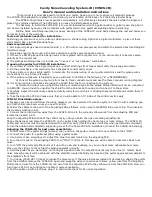
G. Calibration and Zero Checks
Model AQSync Air Quality Monitoring Station Manual Rev. A-1
39
G. Calibration and Zero Checks
It is recommended that the user frequently examine the data from the AQSync to be sure
that the readings make sense and the instruments are working properly. For example, on
polluted days ozone readings should be higher, and other pollutants such as particulate
matter might be higher (especially if fires are burning nearby, for example). Outside CO
2
readings should be around 400 ppm. If an EPA monitoring station is located nearby, the
AQSync
’s readings could be compared to the station readings.
G.1 Calibration
In addition to the routine observations of the functioning of your AQSync Air Quality
Monitoring Station mentioned above, periodic (typically annual) calibration is
recommended. The various modules of the AQSync can be removed and exchanged
for calibrated modules from the factory. Calibration recommendations are given in the
table in Section H.1.7.
If desired, the user can carry out calibrations for the various instruments in the AQSync.
A field calibration of the NOx and ozone modules is recommended at 6 months of
operation
. Please see Appendix 3 for more information on carrying out calibrations.
G.2 Zero Checks
Zero checks can be carried out if convenient, either periodically or when instrument
performance exhibits potential problems.
G.2.1
Ozone Monitor
The AQSync Ozone module is the 2B
Technologies Model 108-L Ozone Monitor (link
to user manual in Appendix 1). To zero the
instrument, open the AQSync and disconnect
the inlet tubing from the bulkhead fitting (left side
of the AQSync). Attach the ozone scrubber
(provided with your AQSync) to the inlet tubing.
Once you have completed the setup as shown,
follow the steps below to zero the ozone
instrument.
1. Power up the AQSync. For an accurate
measurement, the instrument must have
been turned on long enough for the
internal temperature to stabilize (normally
~30 minutes).
AQSync
ozone
inlet line
and filter
Ozone
scrubber
assembly
















































